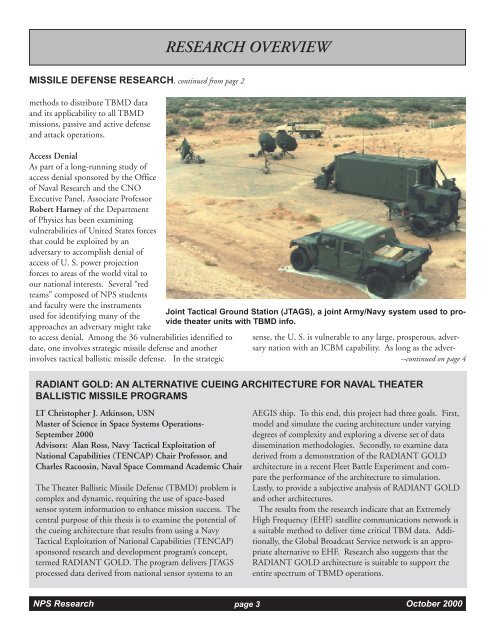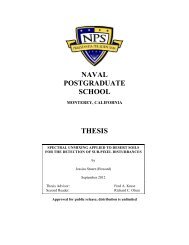October 2000 Newsletter - Naval Postgraduate School
October 2000 Newsletter - Naval Postgraduate School
October 2000 Newsletter - Naval Postgraduate School
You also want an ePaper? Increase the reach of your titles
YUMPU automatically turns print PDFs into web optimized ePapers that Google loves.
MISSILE DEFENSE RESEARCH, continued from page 2<br />
methods to distribute TBMD data<br />
and its applicability to all TBMD<br />
missions, passive and active defense<br />
and attack operations.<br />
RESEARCH OVERVIEW<br />
Access Denial<br />
As part of a long-running study of<br />
access denial sponsored by the Office<br />
of <strong>Naval</strong> Research and the CNO<br />
Executive Panel, Associate Professor<br />
Robert Harney of the Department<br />
of Physics has been examining<br />
vulnerabilities of United States forces<br />
that could be exploited by an<br />
adversary to accomplish denial of<br />
access of U. S. power projection<br />
forces to areas of the world vital to<br />
our national interests. Several “red<br />
teams” composed of NPS students<br />
and faculty were the instruments<br />
Joint Tactical Ground Station (JTAGS), a joint Army/Navy system used to pro-<br />
used for identifying many of the<br />
vide theater units with TBMD info.<br />
approaches an adversary might take<br />
to access denial. Among the 36 vulnerabilities identified to sense, the U. S. is vulnerable to any large, prosperous, adver-<br />
date, one involves strategic missile defense and another sary nation with an ICBM capability. As long as the adverinvolves<br />
tactical ballistic missile defense. In the strategic<br />
--continued on page 4<br />
RADIANT GOLD: AN ALTERNATIVE CUEING ARCHITECTURE FOR NAVAL THEATER<br />
BALLISTIC MISSILE PROGRAMS<br />
LT Christopher J. Atkinson, USN<br />
Master of Science in Space Systems Operations-<br />
September <strong>2000</strong><br />
Advisors: Alan Ross, Navy Tactical Exploitation of<br />
National Capabilities (TENCAP) Chair Professor, and<br />
Charles Racoosin, <strong>Naval</strong> Space Command Academic Chair<br />
The Theater Ballistic Missile Defense (TBMD) problem is<br />
complex and dynamic, requiring the use of space-based<br />
sensor system information to enhance mission success. The<br />
central purpose of this thesis is to examine the potential of<br />
the cueing architecture that results from using a Navy<br />
Tactical Exploitation of National Capabilities (TENCAP)<br />
sponsored research and development program’s concept,<br />
termed RADIANT GOLD. The program delivers JTAGS<br />
processed data derived from national sensor systems to an<br />
AEGIS ship. To this end, this project had three goals. First,<br />
model and simulate the cueing architecture under varying<br />
degrees of complexity and exploring a diverse set of data<br />
dissemination methodologies. Secondly, to examine data<br />
derived from a demonstration of the RADIANT GOLD<br />
architecture in a recent Fleet Battle Experiment and compare<br />
the performance of the architecture to simulation.<br />
Lastly, to provide a subjective analysis of RADIANT GOLD<br />
and other architectures.<br />
The results from the research indicate that an Extremely<br />
High Frequency (EHF) satellite communications network is<br />
a suitable method to deliver time critical TBM data. Additionally,<br />
the Global Broadcast Service network is an appropriate<br />
alternative to EHF. Research also suggests that the<br />
RADIANT GOLD architecture is suitable to support the<br />
entire spectrum of TBMD operations.<br />
NPS Research page 3<br />
<strong>October</strong> <strong>2000</strong>
















